August Short Fuses – Materia Critica
Each month, our arts critics — music, book, theater, dance, television, film, and visual arts — fire off a few brief reviews.
Classical Music
Semyon Bychkov and François-Xavier Roth might not be the first conductors one associates with the music of Gustav Mahler. But both have compelling new recordings of his Fourth Symphony that warrant attention.
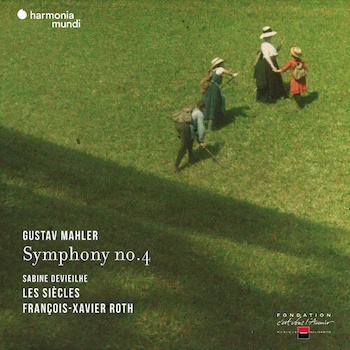 In Bychkov’s performance (Pentatone) with the Czech Philharmonic, tempos are consistently well judged and fluent, textures clean. The first movement is warm and spacious: nothing pushes too hard. Yet the Philharmonic’s playing here — as well as during the second movement, where the violin solos are firmly idiomatic (and vigorously articulated) — is stylish.
In Bychkov’s performance (Pentatone) with the Czech Philharmonic, tempos are consistently well judged and fluent, textures clean. The first movement is warm and spacious: nothing pushes too hard. Yet the Philharmonic’s playing here — as well as during the second movement, where the violin solos are firmly idiomatic (and vigorously articulated) — is stylish.
While the slow movement’s lower voices don’t always project firmly, the reading is very well directed, the contrasts between the music’s two principal thematic ideas coming across strongly. Soprano Chen Reiss’s account of the finale’s “Das himmlische Leben” is pleasingly pure-toned and clear, though a touch literal: as at points in the first movement (like the start of the recapitulation), some bolder contrasts and stronger underlining of moments of arrival might have paid dividends.
Roth’s take on the piece (for Harmonia mundi) with his period ensemble, Les Siècles, is leaner and a shade faster. True, there’s a certain grittiness to the orchestra’s playing, but it never comes over as raw or off-putting — in part, perhaps, because of the group’s attentive shaping of dynamics and articulations. Rather, what one’s struck by in this performance is the music’s sheer weirdness: its embrace of banality and uplift, its inventive instrumentation, its thematic unity.
Above all, Roth’s is a terrifically natural Mahler Fourth. The melodic writing, especially in the first and third movements, floats. If the violin solos in the Scherzo lack some of the schwung of Bychkov’s account, the play of light and shadow Roth draws from his forces — as well as the dance-oriented quality of the movement’s slower parts — is exquisite. Best of all, with soprano Sabine Devieilhe, this finale is impeccably executed.
For tonal blend, diction, intonation, rhythmic clarity, and textural lucidity, it’s hard to imagine a better or more sympathetic performance of David Lang’s the writings than this one.
 David Lang’s hour-long choral essay the writings has been in the works for a while: its earliest movement, “again (after ecclesiastes),” dates from 2005, the most recent (“if I am silent (after the book of esther)”) from 2019. Yet the score, which sets five texts from the Hebrew Bible, retains a striking continuity of character and style.
David Lang’s hour-long choral essay the writings has been in the works for a while: its earliest movement, “again (after ecclesiastes),” dates from 2005, the most recent (“if I am silent (after the book of esther)”) from 2019. Yet the score, which sets five texts from the Hebrew Bible, retains a striking continuity of character and style.
Part of the reason for this is that Lang’s writing is, broadly speaking, meditative. Granted, there’s a certain redundancy of texture and tempo across its six movements (“again” is sung at the writings’ beginning and end). However, there’s a good bit of contrast and variation, too.
The music’s circular quality is established in the flowing patterns of “again.” They’re echoed in the discreet melodic writing near the end of “if I am silent” as well as in the chaconnelike structure of “solitary (after the book of lamentations).”
Textural contrasts loom large. In “if I am silent,” the harmonies are sometimes richly pungent. “for love is strong (after the song of songs)” offers a hypnotic blend of rhythmic layerings (slow and sustained against fast and energetic), as well as a beguiling mixing of solo voices with the larger ensemble.
Throughout, Lang’s structuring of his musical arguments is logical. The alternations of sound and silence in “where you go (after the book of ruth)” culminate in a lovely, consoling coda. Similarly, “solitary” functions as a bold stand-alone movement as well as a potent summation of the larger piece.
For tonal blend, diction, intonation, rhythmic clarity, and textural lucidity, it’s hard to imagine a better or more sympathetic performance of the writings than the one the Cappella Amsterdam and conductor Daniel Reuss deliver here (on Pentatone). For Lang fans, then, this release is a must; for the Lang-curious, it’s a captivating introduction to the composer’s musical language.
Tenor Andrew Staples achieves mixed success in his disc of Benjamin Britten song cycles
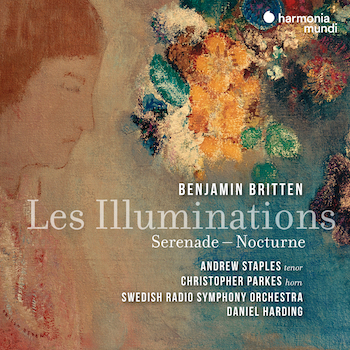 Tenor Andrew Staples certainly knows his Britten, as this new recording (on Harmonia mundi) of Les Illuminations, Serenade, and Nocturne with Daniel Harding and the Swedish Radio Symphony Orchestra demonstrates.
Tenor Andrew Staples certainly knows his Britten, as this new recording (on Harmonia mundi) of Les Illuminations, Serenade, and Nocturne with Daniel Harding and the Swedish Radio Symphony Orchestra demonstrates.
His singing in each is consistently clean and clear. There’s no undue heaviness of tone or hiding behind vibrato or searching for the notes in these performances. In this, Staples recalls the best practitioners of this repertoire: Peter Pears, Robert Tear, and Ian Bostridge.
At the same time, he brings a distinctive flair to certain spots. The melismas in Les Illuminations’ “Marine” and Serenade’s “Hymn” are vigorously articulated. The latter’s “Dirge,” too, has a sort of brogue-ish quality. And there’s enchanting warmth to be had in Nocturne’s “On a poet’s lips.”
Yet there’s also some stiffness to each of these performances. It’s not so much a matter of tempo as it is playing (and, occasionally, singing) that veers on the side of caution.
In Les Illuminations, for instance, one misses the mystery and magic of Pears enunciating these texts with Britten and the London Symphony. True, it doesn’t help that “Parade’s” low Gs come out as a guttural sprechstimmes (why not just observe the ossia up an octave?). But that movement’s Animato isn’t so free or hair-raising as it needs to be. Nor does “Villes” pack enough characterful abandon.
The Serenade features better balances between soloists and strings but is interpretively uneven: how else to explain the unscary instrumental climax of the “Dirge” juxtaposed against the thoroughly playful account of the “Hymn”? At least Christopher Parkes’s horn solos soar.
Strongest is the Nocturne, with its excellent realization of the obbligato instrumental solos. Yes, Staples opts to sing (rather than harrowingly declaim) the climax of “But that night.” But the following movements’ English horn solos and nimble flute/clarinet duets largely compensate.
— By Jonathan Blumhofer
Jazz
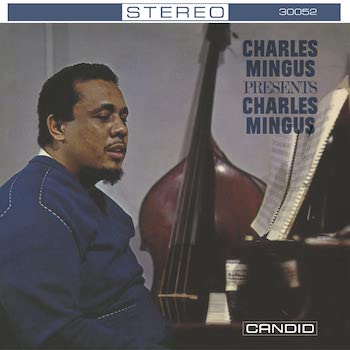
“Good evening, ladies and gentlemen, we’d like to remind you that we don’t applaud here at the Showplace — or wherever we’re working. So, restrain your applause, and if you must applaud, wait until the end of the set, and it won’t even matter then. The reason is that we are interrupted by your noise. In fact, don’t even take any drinks. Or no cash registers ringing. Et cetera….”
The statement is, of course, a ruse. The Charles Mingus Jazz Workshop quartet was recording not at a live venue but at the Nola Penthouse Sound Studios, and they wanted to simulate the live ambience of their performances at the Showplace in Greenwich Village (where, producer Nat Hentoff’s liner notes tell us, they had been “in volcanic residence for nearly a year.” Oh, such were the joys!).
But Mingus’s introduction does indeed set the stage for this 1960 set (released in 1961, now being reissued by Candid) — fast, loose, funny, and deadly serious. (If you ever saw Mingus stop a show cold because of an insubordinate flash photographer, you know what I mean.)
As one of jazz’s all-time master bassists and a towering composer, Mingus (1922-1979) had been releasing one astonishing set of compositions after another, including more than a handful that have entered the realm of standards (“Goodbye, Porkpie Hat”), near-standards (“Self-Portrait in Three Colors), and oughta-be standards (“Boogie Stop Shuffle,” “Better Get It in Your Soul,” “Peggy’s Blue Skylight,” “Portrait of Jackie,” “Moanin’”).
The four performances collected on Charles Mingus Presents belong with the quintessential recordings of Mingus’s small groups from roughly the same period — on a par with the classic releases on Atlantic (Pithecanthropus Erectus, Blues & Roots, Oh Yeah) and Columbia (Mingus Ah Um, Mingus Dynasty).
Charles Mingus Presents was seen by some as a response to Ornette Coleman — stripping his band down to the “pianoless” format of the Coleman quartet, with just Mingus and lifetime wingman Dannie Richmond, on drums, joined by trumpeter Ted Curson and the wildcard, multi-instrumentalist Eric Dolphy.
Here were all the Mingus hallmarks — the passages of collective free counterpoint, the manipulation of meter and tempo, the deep blues feeling, the melodic gift, and the ingenious compositional design to hold it all. “Original Faubus Fables” had been recorded earlier and would show up on other live recordings, but as far as I know, the other pieces, at least under these titles, are rarities.
The spare format presented options of greater harmonic freedom and rhythmic mobility. Check the opener, “Folk Forms, No. 1.” Mingus’s riffing bass intro establishes the basic rhythmic motif that will set the course for the entire piece, picked up by Richmond’s snare, then Dolphy’s alto, then Curson’s trumpet. There’s a relaxed “middle-eight” variation stated by Curson, but from then on it’s nearly constant hurtling four-way counterpoint for 12 minutes. “All The Things You Could Be By Now if Sigmund Freud’s Wife Was Your Mother” (taking off from the standard “All the Things You Are”) is relentlessly fast bebop, Mingus style, with all the asides, out-of-tempo passages, double-times, stop-times, what have you, and some particularly fiery playing from Curson and Dolphy. “Fables of Faubus” is the unexpurgated version of the scabrous civil rights satire that had appeared on Mingus Ah Um, with the dialogue between Mingus and Richmond restored as counterpoint to the Weill-like melody.
“What Love” (referencing another standard, “What Is This Thing Called Love”), aside from the austere harmony of its beautiful melodic theme, includes the astonishing duet — lover’s quarrel, really — between Mingus’s bass and Dolphy’s bass clarinet. It followed Dolphy and Curson’s announcement that they would be leaving the band. Here, “call-and-response” takes on a whole new meaning, with bandleader and sideman arguing in short phrases that sometimes overlap in an increasingly heated exchange — Mingus a marvel of eloquence in the upper register, Dolphy pushing the vocal quality of the bass clarinet for all it’s worth — before resolving their differences with a return to the theme.
The list of Mingus masterworks far exceed what’s mentioned here — including the ballet suite The Black Saint and the Sinner Lady (Impulse) and the posthumously recorded epic Epitaph (Columbia), arranged by Gunther Schuller. There’s much Mingus that’s as good as Charles Mingus Presents, but nothing better.
— Jon Garelick
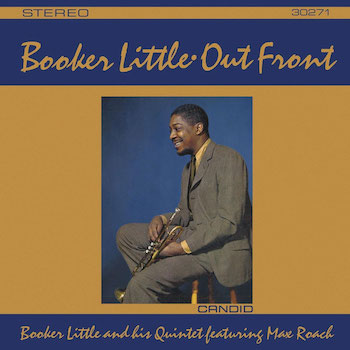 The cohort of ’50s trumpet players is a pretty astonishing lot. Booker Little, one of that (often ill-fated) group, died of uremic poisoning at 23 and only recorded between 1959 and 1961. The album Out Front (released in 1961, now being reissued by Candid), is arguably the best recorded representation of his unique voice as trumpeter and composer-arranger. The lineup: Booker Little, trumpet; Eric Dolphy, alto sax; Julian Priester, trombone; Art Davis and Ron Carter, bass; Don Friedman, piano; and Max Roach, drums. All compositions are by Little.
The cohort of ’50s trumpet players is a pretty astonishing lot. Booker Little, one of that (often ill-fated) group, died of uremic poisoning at 23 and only recorded between 1959 and 1961. The album Out Front (released in 1961, now being reissued by Candid), is arguably the best recorded representation of his unique voice as trumpeter and composer-arranger. The lineup: Booker Little, trumpet; Eric Dolphy, alto sax; Julian Priester, trombone; Art Davis and Ron Carter, bass; Don Friedman, piano; and Max Roach, drums. All compositions are by Little.
From Memphis and schooled at the Chicago Conservatory, Little was a master technician on the trumpet. His unique tone managed to be both pleading and stentorian, copper and silver, focused but not excessively narrow. His varied use of vibrato, and of the extreme registers of the horn, together with his compositions, were the tools he used to investigate crucial, foundational aspects of jazz.
Although less bluesy/funky, there’s something of Charles Mingus in Little’s compositions, particularly in the stops and starts, along with the variations in tempo. I also hear similarities to the voicings used by Wayne Shorter in his arrangements, such as, for example, in Freddie Hubbard’s 1963 album Body and Soul. (Why so many Shorter tunes have become standards while Little’s are seldom played may be a result of the often through-composed structure of his compositions and, of course, the brevity of Little’s career).
Little was looking for a certain kind of freedom, but it was not the freedom of Ornette or of Dolphy, though they sound very natural playing side by side. Little’s idea of liberty called for more strictures. “Moods in Free Time” is a good reflection of this. The time here is not “free” in the customary sense. It derives its flexibility from a subtly crafted shifting of time signatures — from 3/4 to 4/4 to 5/4 to 6/4 meter.
The songs “Man of Words “and “Hazy Hues” are actually “program music” — a format seldom approached in jazz. The first is Little’s attempt to describe the journey of a writer confronting a blank piece of paper. Ideas are tested until a pattern emerges; at that point the real work has been accomplished. The second tune, almost a concerto for trumpet, limns a painter at work, starting with the germ of an idea and bringing it to completion.
Despite Little’s technical proficiency and knowledge of harmony, he considered technique less important than communication. Little said, “If you insist that this note or that note is wrong … you’re thinking conventionally–technically, and forgetting about emotion.…There are certain feelings that you might want to express that you could probably express better if you didn’t have that [bounding, continuous] beat. Up until now if you wanted to express a sad or moody feeling you would play the blues. But it can be done in other ways.”
Little’s oeuvre is distinctive and deserves wider attention. This reissue is an excellent place to begin to explore his very brief career. Don’t be surprised if you listen and two thoughts arise: “Why didn’t I know this music?” and ”What if…”
— Steve Provizer
Theater

A scene from Shakespeare and Company’s Much Ado About Nothing. Photo: Nile Scott Studios
Shakespeare & Company delivers the shenanigans of William Shakespeare’s Much Ado About Nothing (at the outdoor New Spruce Theatre Lenox, through August 14) at full-force, encouraging a talented cast to let loose. Everything you expect in a Bard rom-com and more is delivered with zest: love, confusion, lyrical verse, witty rejoinders, and the somewhat mysterious villains who postpone the inevitable arrival of happiness. And there are generous servings of humor and silliness throughout. Shakespeare’s poetry leaves plenty of room for physical comedy.
In Messina, triumphant soldiers Don Pedro, Claudio, and Benedick return looking for love. Except for Benedick, who runs up against the feisty wit of the disdainful Beatrice. (She, unlike everyone else in the play, thinks love is a waste of time.) Of course, B & B find heartfelt romance, a coupling highlighted by the comic sass of Tamara Hickey’s Beatrice. Meanwhile, Claudio becomes enamored with Hero (Beatrice’s cousin), but he is a bit too easily swayed by Don John’s mischief-making plot.
Dancing, hopping, running, marching, and waltzing across the stage, the Shakespeare & Co performers are in perpetual motion. Benedick and Beatrice confess their love for each other, while Hero and Claudio (somewhat implausibly) work things out. Kelly Galvin’s good-natured vision of the play seems inspired by the Countess’s advice in All’s Well That Ends Well: “Love all, trust a few, do wrong to none.”
— Sasha Ray
Books
John Lorinc sensibly argues that digital technology is not the silver bullet that will eradicate urban ills.

A 1516 woodcut from Sir Thomas More’s Utopia.
The utopian promise of “smart cities” has been around now for at least two decades. Urban planners and developers have dreamed of melodiously intertwining advanced technology and the city. To the tune of hundreds of billions of dollars worldwide, the tech industry is now busily cranking out “smart” city software and hardware. But so far these orchestrations have sounded distinctly atonal.
In his new book Dream States: Smart Cities, Technologies and the Pursuit of Urban Utopias (Coach House Books, 282 pages), author John Lorinc thoughtfully examines the contradictions and conundrums generated by urban innovations and new “tools.” The problems are often found in the awkward integration of technology into civic realities. Armed with the results of considerable international research, the author explores how high tech’s future-perfect systems chafe against highly bureaucratic administrations, challenging their economics and political realities. Smart city mega-projects — propelled by their dependence on e-government as well as their embrace of climate and pandemic preparedness tools, overlook the messier aspects of urban life and the pitfalls of local bureaucracy. The engineering process offers partial answers (streetlights, water quality, etc.) but neglects the fact that urban problems are rooted in the muddled nature of real human beings.
Another issue: the tech industry comes on like a snake oil salesman — promises have been made that they can’t deliver on. An effective urban utopia is not going to be the simple digital dream of individuals who write code with little or no sense of what life is like. The author points out that, though some aspects of day-to-day urban activities have been greatly assisted by technology, the alleged miracle power of digital assistance has been oversold. Sprinkle in buzz words such as “creative cities,” “intelligent cities,” and “economic clusters” and you have virtual idealistic visions that don’t confront serious difficulties, including social justice, urban decay, or even gentrification. This discrepancy is not new: throughout history utopian schemes have come into conflict with the challenges of realpolitik. And then there are current worries about preserving individual privacy.
In 1516, English social philosopher Sir Thomas More published a book titled Utopia. It compared social and economic conditions in Europe with those of an ideal society on an imaginary island located off the coast of the Americas. More underscored that the perfect conditions on his fictional island could never really exist. The current use of “utopia” refers to an ideal place or society. As can be seen from its Greek roots, utopia means “no place.”
Lorinc argues that digital technology is not the “silver bullet” that will eradicate urban ills. Instead, when administered in the proper doses, he suggests it can make the patients a bit healthier — though the condition of our cities will remain chronic. This valuable message is delivered via a thoroughly considered analysis of engineering vs utopian concepts, a study that keeps the human condition front and center.
— Mark Favermann
The jig is up, and the arts establishment will have no choice but to create (and market its wares) under the unifying conditions dictated by the Anthropocene.
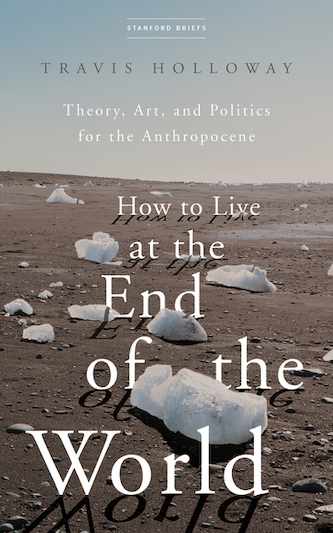 From what I can tell, arts criticism seems to be either ignoring climate change (aside from an occasional wringing of hands) or assuming that, along with some earnest, face-saving adjustments here and there, the cultural industrial complex — in and out of academia — will be churning out product as usual. Business will remain about the same, with some adjustments for meltdowns and floods here and there. A standard example of the latter approach can be found in Harvard University Professor Martin Puchner’s tepid Literature for a Changing Planet, in which understandably anxious students are advised to read a good book (preferably from world literature) as the earth burns.
From what I can tell, arts criticism seems to be either ignoring climate change (aside from an occasional wringing of hands) or assuming that, along with some earnest, face-saving adjustments here and there, the cultural industrial complex — in and out of academia — will be churning out product as usual. Business will remain about the same, with some adjustments for meltdowns and floods here and there. A standard example of the latter approach can be found in Harvard University Professor Martin Puchner’s tepid Literature for a Changing Planet, in which understandably anxious students are advised to read a good book (preferably from world literature) as the earth burns.
So it is bracing to come across a thoughtful volume that faces an elemental truth and moves on from there. Dealing with the escalating degeneration of the climate will make unprecedented demands on our understanding of ourselves and life on this planet. Conditions are pushing us into a brave new world — and, because of our self-destructive procrastination, we are being forced to do so quickly, deepening the trauma. Not only will what has to be done for the earth’s survival drive revolutions in economics, food production, and politics. Art and its commentators will no doubt be overhauled as well — in ways that we can’t predict. Sensing that looming reality must be nerve racking for the comfortable set; their refusal to cast their self-protective contentment must be part of what is driving critical denial of the facts of the matter.
Poet and philosopher Travis Holloway will have none of the current shilly-shallying in his compact book How to Live at the End of the World (Stanford University Press, 130 pages). The jig is up, and various establishments (including the arts) will have no choice but to confront the inevitably unifying conditions dictated by the Anthropocene. Like it or not, we are on the brink of catastrophe, faced with the collective loss of a reliable and habitable future.
The Anthropocene story shifts our narratives away from individual life, literary confession, and human capital towards the oceans that surround us and the histories beneath our feet. In an era of capitalism that depends on self-capital and self-entrepreneurship, the Anthropocene offers a poetics that collectivizes us and politicizes us, and marks an end to the end of history. On the one hand, a narrative like this holds a certain promise for helping us see ecological or political issues not just through the lens of private concerns or individual moral responsibility, but in terms of an entire biosphere, and in terms of the collective actions that we must take if we are to prevent further catastrophe and act better in its midst. On the other hand, any story that has the potential to collectivize us must simultaneously be differentiated in terms of power and capital if it is to be of any real use.
Holloway moves on to explore that radical premise in three short chapters, the first speculating about the kind of histories that must be written now that, according to one critic, “human exceptionalism and bounded individualism, those old laws of Western philosophy and political economics [have] become unthinkable.” Another chapter speculates that democracy, for the sake of our survival, will need to evolve into a more expansive form, becoming into what the author calls “a zoocracy, a rule of assembly of all the living.” Philosophy’s responsibility, in part, to encourage this process is “to deconstruct forms of life and thought that separate ourselves from earth, that exclude other forms of life from each other, and propose a way of life that does the opposite. We must enlarge the public sphere and learn how to make visible those who are invisible, including other species and the earth.” The arts and literary studies in the future may be encouraged to move in that noncorporate direction.
The author suggests one of the directions creativity is taking in a chapter that examines how, over the past few centuries, artists and philosophers have looked at clouds. Holloway notes, approvingly, the birth of “a new kind of art [that] is responding to the experience of more violent weather due to climate change.” My reservation is that his focus is on artists who respond — imaginatively but also overtly — to external weather conditions. Raymond Williams’s concept of “structures of feeling” underlines how art often reflects political and environmental pressures in a variety of nuanced ways — via changes in form and vocabulary, via inflections of speech, the use of colors, rhythms, and shapes. We are entering an unprecedented “age of anxiety” (apologies to W.H. Auden). Artists will no doubt dramatize that chronic insecurity — which is here to fester — in diverse ways. Short and provocative, this is my kind of “how to” book.
— Bill Marx
Television
Wedding Season is an Indian story that just happens to follow the beats of a traditional rom-com.

Pallavi Sharda and Suraj Sharma in Netflix’s Wedding Season.
Is there anything more filling than a good rom-com? It is comfort food designed to leave a tummy content.
Over the years, multiple chefs have been playing around with the standard recipe, and directors and writers of various backgrounds have come up with some surprisingly tasty dishes. Like fusion cuisine, the best of these new concoctions are as delectable as the rom-coms of old — they just may be spicier.
Netflix’s Wedding Season provides the kind of cheese ball moments romance fans crave. Set in New Jersey, the film opens with Asha (Pallavi Sharda), a messy, career-driven woman whose dating profile is the photo negative of reality. That’s because it was written by her mother, Suneeta (Veena Sod), who is determined to marry her daughter off to an educated, successful, and traditional Indian man. Asha begrudgingly agrees to go on a date with Ravi (Suraj Sharma), who is exactly the kind of guy her mother wants her to marry: an MIT graduate who has his own startup. Ravi is facing the same kind of overbearing pressure from his parents as well. So, in true rom-com fashion, the pair agree to “fake” a relationship. They parade their farce togetherness across multiple weddings (just like the title of the movie!) to the delight of their parents and the gossipy Indian aunties.
It turns out that Sharma and Sharda do have good chemistry. While their relationship doesn’t feel particularly romantic, their banter is playful — it is amusing to watch them verbally spar. Asha is a particularly interesting rom-com lead: a math whiz, she has an admirable job (she helps set up microloans for women in developing countries). She’s sarcastic, but also caring — she clearly loves her sister, Priya (Arianna Asfar) who is marrying Nick (Sean Kleier), a befuddled white man who is trying a little too hard to learn about Indian culture.
This is not to say Wedding Season doesn’t depend on traditional rom-com tropes. Asha is asked to impress a big client; Ravi isn’t exactly who he says he is; wedding planning is involved; and Asha’s boss serves the “gay best friend” role. It would be nice to do away with these cliches, but that would make rom-coms less enjoyable. Basking in the familiar is one reason we watch.
What makes Wedding Season different is its exploration of Indian culture, specifically the struggles that children of immigrants often face regarding assimilation. Given that their parents sacrificed so much for them, both Asha and Ravi both feel the need to make their parents proud, compelled to do what they ask. The compulsion to be the perfect child takes a toll on both Asha and Ravi, a theme that is starting to be explored in more movies (i.e. Encanto). The film also delves into the nuances of Indian culture, new territory for rom-coms.
Most rom-coms feature fabulous fashion, and costume designer Courtney Mitchell does not disappoint — she serves up a vibrant feast for the eyes. Every one of Asha’s saris are breathtaking. (Even her everyday wear is envy worthy.) Ravi’s outfits are gorgeous as well. The recent wave of rom-coms prove that diverse ingredients can be mixed-and-matched successfully. Wedding Season demonstrates that gulab jamun is yet another delicious addition.
— Sarah Osman
Tagged: Andrew Staples, Booker Little, Candid Records, Capella Amsterdam, Charles Mingus Presents, Climate Change, Coach House Books, Daniel Reuss, David Lang, Dream States: Smart Cities, Francois-Xavier Roth, Harmonia Mundi, How to Live at the End of the World, Jon Garelick, Jonathan Blumhofer, Mark Favermann, Much Ado About Nothing, Out Front, Pentatone, Sasha Ray, Semyon Bychkov, Shakespeare & Company, Stanford University Press, Steve Provizer, Technologies and the Pursuit of Urban Utopias, Travis Holloway
